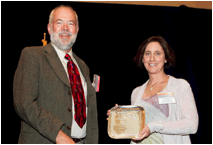Friday, October 26, 2012
Using cosmic rays to study Fukushima reactor
LANL Muon Radiography team members stand in front of the damaged Fukushima Daiichi reactor complex. LANL photo.
In a new paper in the journal Physical Review Letters, scientists at Los Alamos National Laboratory have confirmed that they can use cosmic rays to pinpoint the location of nuclear material inside the reactor buildings.
The technique is called muon radiography, a scattering method developed after the 9/11 terrorist attacks that can be used to produce images of objects the particles strike, similar to how x-rays work, only with less damage to the objects they contact. It's also used to detect potentially smuggled nuclear materials. (Full Story)
LANL performs tests at Japanese site
3D animation of Fukushima Reactor 1 created at Los Alamos National Laboratory in 2011.
The cleanup at Japan’s Fukushima Daiichi nuclear power plant may take years, but researchers from Los Alamos National Laboratory think they’ve found a way to speed up the process.
Since March 11, 2011, when the site suffered the double whammy of a magnitude 9 earthquake and tsunami, which triggered the meltdown of three of its reactors, Japanese officials has been struggling with how to deal with the cleanup.
But last May, LANL’s muon radiography team donned hazmat suits and got close enough to test a method that could be used to locate nuclear materials at the site. (Full Story)
Frost on Mars? Curiosity uses its laser to probe mystery
The target dubbed “Crestaurum,” hit with over 30 laser shots, leaving behind a hole 3 millimeters wide. NASA.
The Mars Curiosity rover, cozy at the sandy, windblown patch of ground called Rocknest, pulled out its laser late last week, aimed it at a target about 9 feet away and started zapping.
The goal? To find out whether frost accumulates on Mars' surface at night, according to Roger Wiens of Los Alamos National Laboratory.
"The idea was to take one measurement of Crestaurum at night and one during the day for comparison," the scientist and principal investigator for Curiosity's ChemCam instrument told the Los Angeles Times. (Full Story)
How earthquakes make the ground go boom
Seismic and infrasound data collected by the University of Utah Seismic Network. University of Utah.
A new study finds the Earth's surface acts like a speaker for low-frequency vibrations, transmitting an earthquake's infrasonic tumult into the air.
“This is really the first successful model for earthquake infrasound. It means that we can predict what we expect to see from earthquakes versus underground explosions, for example,” said study author Steve Arrowsmith, a researcher at Los Alamos National Laboratory. (Full Story)
Scientists show earth’s surface acts as a giant loudspeaker
Acoustic scientists have shown in a new study that the Earth’s surface and atmosphere act as a giant loudspeaker. This “loudspeaker” soundtracks these geologic raves in both the audible range of hearing and in infrasound.
According to the computer modeling, sound recordings and seismic data used in the study, an earthquake “pumps” the surface and the atmosphere above it, “It’s basically like a loudspeaker,” said Stephen Arrowsmith, a researcher at Los Alamos National Laboratory. (Full Story)
CMU joins forces in repurposing supercomputers
Director Charlie McMillan and Andree Jacobson of the New Mexico Consortium in the PRObE machine room. LANL photo.
Supercomputers from the Los Alamos National Laboratory once went to the desert to die. That’s no longer necessary. Officials at Los Alamos, the NSF, the New Mexico Consortium and CMU joined forces to launch PRObE, a one-of-a-kind supercomputer research center.
Gary Grider, Los Alamos’ deputy division leader for high performance computing, got the idea for the PRObE center several years ago while decommissioning machines. PRObE stands for Parallel Reconfigurable Observational Environment. (Full Story)
LANL hosts annual LDRD day
Bill Priedhorsky presents the Best Poster Award to Jennifer Hollingsworth and her team for “The Path to Nanoparticle Cancer Drugs.” From the Monitor.
Los Alamos National Laboratory conducted its fourth annual Laboratory Directed Research and Development day at Buffalo Thunder Resort and Casino Tuesday.
LANL funds some of its research through the Laboratory Directed Research and Development Program, a source of internal funding awarded to scientists and engineers to address national problems in the areas of energy security, nuclear security and scientific discovery and innovation. (Full Story)
Physical sciences conference seeks to encourage women in male-dominated field
Dale Tupa has always liked science. A physicist at Los Alamos National Laboratory, she runs diagnostic tests to understand shock physics and explosions. For 24 years, she has worked at the lab. She loves what she does – and she wants other women to love what they do, too. (Full Story)
To subscribe to Los Alamos Report, please e-mail listmanager@lanl.gov and include the words subscribe losalamosreport in the body of your email message; to unscubscribe, include unsubscribe losalamosreport.
Please visit us at www.lanl.gov
And follow us on Facebook, Twitter, YouTube, and Flickr















